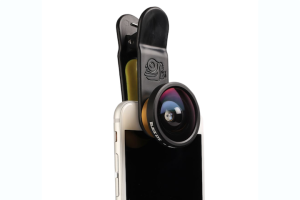Sál, Black Eye, Mobile net, 2015, Public domain
In today world of technology, people are coming up with new and innovative conveniences all the time. The huge computers had been replaced by small notebooks, tablets or smartphones. Also people invent modern versions of these devices. As we can see the world of technology is growing very fast. And as a result of it, lens adapters, that you might have seen used only with cameras, were adapted also for your smartphones.
Firstly, it is important to understand what it is a lens adapter. The lens adapters for camera work basically the same as the lens adapters for smartphones. They are composed of an assembly of lenses that create an image. These lenses are changing their position due to zooming in or out, and so a photo changes its final look. Therefore, lens adapters can improve smartphone´s camera and you can take photos more according to your vision.
How does it work?
For better understanding of utilization of lens adapters for smartphones, let´s simply explain how they work. Just before attaching lens to smartphone, there is a need for a magnetic ring that has to be sticked to your mobile´s lens. After attaching the magnetic ring, you can add lens adapter.
However, for running a lens adapter you need to connect it to your smartphone by a certain application or some lenses can be also connected to the Wi-Fi and so to your smartphone. After installing that application to your smartphone, you can start to use lens adapter and discover abilities of different lens adapters.
Types of lens adapters:
As you may know something about the diversity of lens adapters for common cameras, the types of lens adapters for smartphones are the same. Let´s see the basic kinds of them.
The first lens adapter is called macro lens adapter. This type is able to zoom in very close to any object. The most common macro lenses can take photo from distance 10-15 mm far from an object. This lens adapter is very suitable for example for taking photos of flower´s blooms or taking very detailed profile photos.
Secondly, there is another type called wide-angle lens that is basically like a micro lens. The ability of this lens type is to include the widest shot as possible. An angle of a shot can reach 160°. This type is appropriate for taking panorama photos or for photos of an interior of a room.
The third most commonly used type is so called fisheye. This one is also type of micro lens. It is a special one, because its rang of an angle of a shot can reach 180°. Also this lens deform picture in a very specific way, which you can see on the picture below. In addition, this lens leaves dark rounded edges. Mostly you can appreciate the lens, while taking selfies or motion active photos.
Experiment with lens adapters:
From the review of lens adapter Black Eye from edition Yellow, which was posted in December 2015, we can explore and compare 3 types of lens adapters. These are Macro lens (20x), Fisheye and Wide angle. In this experiment the lenses were attached to iPhone 6s, and then tested by taking several photos.
The macro lens zooms in 20x, so it takes photos from distance 6-12 mm. The lens focuses to the centre and the edges are blurred.
The second lens, fisheye, is supposed to include in a photo as much as possible. The Black Eye´s fisheye can take photo in angle of 180°. As a result, we get a photo looking like a globe or like a paperweight. Again the lens focuses on the centre of a photo and the edges are blurred.
The last lens from Black Eye, wide angle, takes a photo in very wide angle as well. However, the photo is less deformed meaning it looks more realistic that with the fisheye lens. The function of this lens is nicely visible on the photo below.
Due to the review of the test, we can easily see how the different types of lenses for smartphones work.
Finally, to conclude this topic, I should mention pros and cons of lens adapter for smartphones. Everything depends on model of a lens. Some lenses are chargeable, so we need to have another changer and charge the lens separately, which I would tag as a disadvantage. Further, some lenses need a Wi-Fi, so they can connect to smartphone. And in case of problems with the Wi-Fi connection, it might be a problem for running the lens in your smartphone.
On the other hand, I would consider as an advantage the high mobility of these lenses. As we compare these lenses with ones for camera, smartphones´ lenses are definitely smaller and more easily portable.
SOURCES:
http://www.mobilmania.cz/clanky/sony-smartshot-qx10-a-qx100-nasad-a-fot-recenze/sc-3-a-1325341/default.aspx
http://www.mobilephotography.cz/2013/11/objektiv-k-mobilu-cast-23-rybi-oko.html
http://digiarena.e15.cz/blaznive-fotoprislusenstvi-nejen-pro-iphone
http://www.gizmag.com/best-smartphone-camera-photography-accessories/37703/
http://www.mobilephotography.cz/2013/11/objektiv-k-mobilu-je-to-hloupost-nebo.html
http://mobilenet.cz/clanky/recenze-objektivu-black-eye-kdyz-mobil-nestaci-28865


